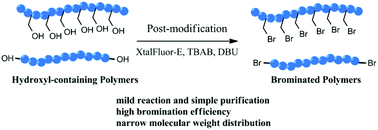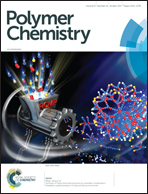Facile and efficient bromination of hydroxyl-containing polymers to synthesize well-defined brominated polymers
Abstract
This article demonstrates a new post-modification method to synthesize well-defined brominated polymers based on the bromination of hydroxyl-containing polymers. Bromination conditions for poly(2-hydroxylethyl methacrylate) (PHEMA) with diethylaminodifluorosulfinium tetrafluoroborate (XtalFluor-E), including solvents, bromine sources, additives, feeding ratios and reaction times were studied in detail. It was found that all –OH groups of PHEMA were quantitatively transformed to –Br groups and that the product maintained a narrow molecular weight distribution with a combination of XtalFluor-E, tetrabutylammonium bromide (TBAB) and 1,8-diazabicyclo(5.4.0)undec-7-ene( DBU) in dichloromethane for 24 h, at a feed ratio of [OH] : [XtalFluor-E] : [TBAB] : [DBU] = 1 : 5 : 5 : 5. Thus, well-defined poly(2-bromoethyl methacrylate) (PBEMA) and its copolymer poly(BEMA-co-MMA) were readily prepared via post-modification of the corresponding PHEMA and poly(HEMA-co-MMA) copolymer at room temperature followed by a simple precipitation procedure. This methodology was additionally applied to obtain α,ω-dibromo and mono-bromo terminated poly(ethylene glycol)s (PEGs) from the corresponding hydroxyl-capped PEGs. The facile and efficient bromination of hydroxyl-containing polymers has the potential to be a universal methodology for the synthesis of a diverse range of brominated polymers.


 Please wait while we load your content...
Please wait while we load your content...